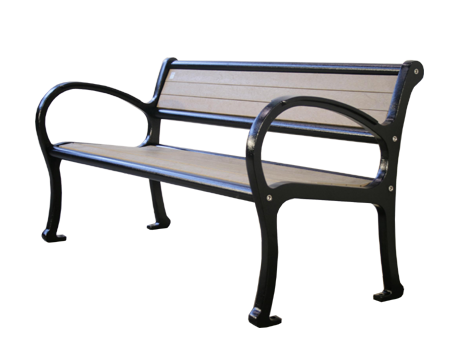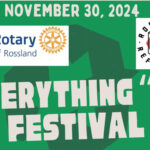Ore cart and all, protracted downtown furniture debate ends where it began
After stalling the purchase of more than $100,000 in street furniture to top off the downtown renovations that began this time last year, council decided the idea of swapping in some pieces made by local artisans—as suggested two months ago by Coun. Kathy Wallace—was “too little too late,” and the city will now buy the catalogue pieces as originally planned.
In addition to the picnic tables and benches, the city’s purchase includes bike racks, recycling bins, and bear-proof garbage cans. The new furniture should be installed by the end of July.
Benches and tables
Wallace began the discussion again at a committee-of-the-whole meeting on Monday dedicated to the topic. She asked staff for a response to the idea that some pieces be “put out to community as some kind of creative project.”
Public Works Manager Darrin Albo reported that municipal insurance did not require CSA-approved furniture, as the catalogue pieces are, but he warned that going with a local artisan is “taking on a risk,” from slivers to people falling off.
The picnic tables and benches are made of a recycled plastic, Albo said, and they all come with a 25 year warranty against cracking, splitting, rotting, and so forth, and a 10 year warranty on the frames and aluminum structures.
“For public works, that’s a huge benefit,” he said. For comparison, he noted that the wooden heritage benches around town are “extremely high maintenance and have to be stained every two years.”
He suggested, “If you’re going to consider something local, make sure it’s maintenance free.” He added his opinion that Harry LeFevre Square beside Ferraros, where the plan calls for two benches and two picnic tables plus the somewhat contentious ore cart feature, “would be an excellent place to showcase some local talent.”
Albo and his crew took a walk-through last week to discuss the operation: “Most [furniture] had to go in and out every year. We bolt them and unbolt them, and that could be hard on some pieces. Mobility has to be there. I’m willing to sit on a task force and discuss this if that’s what council is willing to do,” he said, “but I’ve talked to the guys who do this every year,” and they share the view that pieces ought to be maintenance free and strong enough to handle the spring and fall installations.
Coun. Tim Thatcher, acting mayor as Mayor Greg Granstrom completes his Scandinavian tour, asked Coun. Jill Spearn, a member of the streetscape committee, if local products had been considered.
“I’m of two minds,” Spearn replied. “The concept of local artisan crafted work downtown is a great idea. But when you’re looking at the scale for this project, and the timelines, it makes sense to me that you would go to the efficiencies to order from companies such as this. I don’t know cost-wise, what does ‘Bench A’ cost?”
Albo replied $1600, to which Spearn asked, “$1600 for one bench? What’s in it?” Albo noted the high tech recycled plastic that was “spoken highly of” during the public input charettes “because it will weather better.” The picnic tables cost $2000 each.
Bear-proof garbage containers and recycling
Albo noted that the garbage can supplier has been making them for 35 years. “They have a proven track record on maintenance, what works and what doesn’t. If we go to a local, we have to be very careful about what we’re asking them to build,” he said.
Recycling bins will be installed in three places: outside Ross Vegas, the post office, and Harry LeFevre Square. “Council indicated bus stops,” Albo said, “but we don’t tend to get cans and bottles left around there.” The Ross Vegas site was chosen because, Albo said, “lots come out of Charlie’s store and migrates towards the bank,” and the post office was chosen because “we don’t have one on that side,” which includes a number of food vendors.
There will be more garbage cans than recycling, “probably half a dozen,” Albo said. “They get used lots.” The garbage can sites were chosen by “asking the guys who clean up where we need them.”
Albo added, “I’m sorry to say they get lots of household garbage. It’s not just a chocolate wrapper, but people stuffing the garbage.” Deputy CAO Tracey Butler said, “Now it’s going to be really difficult to get domestic garbage in because it’s like a mailbox, and also wildlife proof.” Unfortunately, Albo said, “It’s not 100 per cent perfect for our application because it’s operated by a foot lever down below, and I’m concerned about snow getting in and jamming it.”
Coun. Kathy Moore suggested the plan could use more recycling bins. “I’m curious about what council’s feelings are about additional recycling,” she asked. “Do we feel 3 is enough for this community that is so green and progressive?”
Coun. Cary Fisher responded “Staff could come back to council at any time if we need more.”
Coun. Jody Blomme commented, “People in a town like ours are generally motivated to walk a half block to get to the recycling bin. I think we should wait until it becomes an issue.”
Wallace asked Albo, “Will that be a possibility in the future?” Albo said yes: the company has been around 35 years and parts are available “off the shelf.”
Spearn agreed with Moore, however. “I think there are a lot of garbage cans and not enough recycling. Should we pull back on the number of garbage cans and have more recycling bins complimenting them instead?”
“I like to think that what Coun. Blomme says is right,” Spearn said, but in the “big picture” if people have recycling in their hand but are faced with a garbage can without a recycling bin, “in it goes,” she said. “I’ve seen it time and again.”
“Unfortunately I’m a bit of an expert in garbage and recycling,” Fisher said, referring to his experience at the golf course. “By and large people respect recycle bins, but you’re never going to stop that bad person from putting a hamburger into the recycle bin.” He said such problems are, unfortunately, just standard maintenance issues.
Wallace asked, “Is there a possibility of finding a recycling-garbage-ashtray combo?” (The discussion on ashtrays is reported separately.)
“I was just looking today,” Albo said, “and yes, they do have combinations, but they’re not ‘bear aware.’ There is a possibility to swap in [bear aware components]. Perhaps council, if possible, could leave that open to our discretion, if I can fit in another recycling bin and take out a garbage can?” He said he would be in contact with the company soon.
Council agreed to this arrangement, although Blomme noted, “In Banff, along the main street there are bear proof bins that are recycling-garbage as one unit. There’s no foot pedal, it’s more like a car door handle, like a mailbox. In any case, such a thing does exist.”
Albo agreed, “There are hand operated ones, but we’re trying to stay away from that because of hygiene and whatnot.”
Bike Racks
“There seem to be an awful lot of bike racks,” Spearn commented. “I know people ride bikes a lot, but I don’t see a lot of people parking their $3000 bikes around town.”
Albo said the plan calls for 10 small and five large racks. The small racks fit two bikes and the large racks fit six.
“Stacey [Lightbourne, the assistant planner] put them in and agreed it may be a little bit excessive, but she went through every location downtown where people seem to lean bikes against a wall or tree,” Albo said, adding, “I would rather zero of them, because that’s how many we have to put in and out [each winter].”
Fisher said, “We’re trying to become a pedestrian-friendly, bike-friendly town. The number on the table may be meant to encourage more cycling and more activity like that downtown. Leaving it as is shows our welcoming attitude to cycling in our city. There may be too many today, but down the road when there’s a mountain bike fest in town for example, every rack could be full.”
Buy local or big box store?
Blomme said, “How I envision this for the garbage cans and recycling bins, if the city feels it’s necessary to replace what we have, then fine, that’s not something I thought we would contract out and build locally. That’s not the issue.”
“This 100-plus-K is an exorbitant amount to send out of the community when we have expertise in town to make this,” she continued. “A piece for artisans to showcase their creativity, that aspect is a bonus, but even without that just having these built in our community makes a lot more sense.”
“Issues about maintenance, warranty, and durability can be dealt with even using local people,” Blomme said. “They’re professionals. It’s about the quality of the wood, the quality of the joints. The bonus is that if they’re local, when an issue does arise, they’re here to deal with it.”
“$100,000 is a lot of money to put out of the community when it could stay in. I’d like to see a local carpenter, artisan, or metal worker being tasked to put it together within the parameters they’re given. I’ve talked to people in the community who do this, and they say it’s very doable, very doable for less money,” she said.
“What we have here is fairly run-of-the-mill. There’s nothing particularly ‘Rossland-screaming’ about what’s being presented here. If we had someone local doing it, we could show them, this is what we’re considering, what’s your version of this? I would very much prefer to put out an RFP [request for proposals.] I think it would be cheaper, better quality, and nicer.”
Spearn replied, “It is typical furniture, yes, but the downtown core is not typical, it’s unique to Rossland. I’m favourable to some pieces that are unique and from local artisans, but I also want a cohesive theme downtown. I wouldn’t mind six pieces that are unique, but as far as the whole scheme of things, I don’t see how technically that would work? At least a year, potentially years.”
“This is the third time through this exact conversation, and we don’t seem to be getting anywhere. I feel strongly we need to finish the downtown, this summer for sure,” Spearn said.
Fisher noted that the purchasing policy doesn’t note “any kind of local preference.” He referred to the recent downtown renovations that used companies from Nanaimo, Kamloops, and Kelowna. “While I applaud [the idea of buying local street furniture], I find it a gesture unless we’re changing the purchasing policy to make a preference. And I don’t see that looking at it from that point of view is necessarily valid. Looking back, picking and choosing, that’s bad policy.”
“I hate to agree,” Spearn said (to a round of hearty laughter,) “but it’s not our job to manage the artisans of our community through this project. Supporting the local economy is great, but I don’t think this is the point in this project.To go back and fuss around with this, I know it drives staff mad, and it drives us into all kinds of directions where we’re freewheeling. There is a time to freewheel, this is not.”
First motion for local artisanal benches rejected
Moore made a motion to “accept the street furniture as it stands, except that we do an RFP for the three benches outside Subway and Rossland Hardware, and the two benches in Harry LeFevre Square.”
She explained that she chose those spots because they are very central and good show places. “I appreciate where staff’s coming from with what we’ve got here, and a lot of public input went into this. I’m disappointed we didn’t have this discussion about doing something unique about one or two years ago, but I agree with Coun. Spearn, we need to move forward and get town finished.”
The motion did not get any traction.
Fisher said, “Our character is built on the BMO building and the post office and the other heritage buildings we have in town. Our character is built on our uniqueness and proximity to mountains. It’s not about whether we have a bike rack that’s unique.”
“I think we’re beating this one up,” he said. “I don’t mind the motion, to have a few benches that are different, but I don’t see them as a game changer to create that level of uniqueness.”
Looking back to the entire downtown renovation, Fisher added, “There was a time when people came up and said, ‘I don’t like the design, it’s not Rossland.’ I look at it now and I think, ‘That’s Rossland,’ it looks great. And now even the naysayers are coming up to say so. There was trepidation regarding furniture and things, changing something causes anxiety around potentially losing the feel of downtown, but I challenge anyone to go out and say Rossland has lots it’s feel. If anything, I think it’s more genuine now.”
Blomme said, “I will not support this motion. My main purpose being here today, in this discussion, my main goal is to keep this money in town.”
Wallace said, “I do regret council didn’t start this conversation years ago, but I do feel like Coun. Blomme expressed. It would be nice to keep this in the local economy.” She suggested council “move away from this motion” and go after the “low hanging fruit” instead.
“I would like to talk about where the design for Harry LeFevre came from,” Wallace said. “I don’t know where it came from. In my opinion, and others I’ve talked to, the Harry LeFevre space is pretty prime real estate for community events downtown to use as a gathering spot.”
(Note: This weekend will showcase the first warm-season community event at Harry LeFevre, the Rossland Radio Co-op’s “Boost the Broadcast” fundraiser.)
“I’m not sure having a mining cart and big bike rack right in the middle is the best use of space,” Wallace said.
Thatcher said, “The way we’re going, I don’t think we’re getting anything downtown this year. I have no problem with any of the furnishings. I think if we went with Coun. Moore’s motion there would be too much contrast.”
“I’d like to see Harry LeFevre with more local flavour, using local artists and tradespeople. The rest of it, I don’t have any problem,” he said.
Spearn was put off by the positioning by the “ex-hardware store” and the Subway. “The asymmetrical approach doesn’t make sense to me, balance would suit my brain more. Maybe we should just go with a couple things in Harry LeFevre.”
Moore explained, “Part of this is my effort to compromise. We would give close to $10,000 to local artisans to come up with something. I would not want wood unless someone can guarantee it’s going to last 25 years, and that would be in the RFP. It’s too late to redo everything, but to have a few pieces be unique would be great, and keep some money in the local economy.”
Wallace said, “I will be voting against, those aren’t the elements I would pull out.”
The motion was defeated with only Moore in favour.
Ore cart survives as Harry LeFevre tweaks are rejected
Earlier in the discussion Fisher had said, “If anything, if people find the ore cart so egregious, we could dump it out and replace it with at least one piece with local artisan flare. For an ore cart, we could go down to Pistak’s [display of mining artefacts on the rail grade trail] and take one of his. He’d be thrilled to do something with one of those things.”
Wallace made a motion: “Let’s remove the mining cart in Harry LeFevre, move the big bike rack out closer to sidewalk, and remove the two ‘A benches’ to be replaced by a local artisan’s work.”
A discussion ensued about where the bike rack would be better locatedm but council did not arrive at a broad consensus before the conversation turned back to the ore cart.
Albo explained, “It’s not really a ‘mining cart.’ It’s just a flat deck table for kids to get up on, it’s just a big seating area.”
This came as news to Wallace as Spearn emphasized, “It’s a platform to sit on, jump on, do whatever on. I like it: it’s moden, flat, but there’s a sense of history. It’s not like one of those out at Pistaks—no offence, I like riding my bike and seeing his museum out there!”
Wallace’s opinion turned in favour of the existing plan, arguing that the changes council was debating were “too little too late.” She added, “The discussion about the warranty and safety approvals makes very good sense.”
Spearn agreed, “We’re whittling away. Is it really worth it for just the two benches?”
Blomme argued that the warranties did not justify the huge increase in cost. “I disagree it would take a lot of time [to get a local product.] These people work quickly. If we’re paying a super huge premium for this 25 year warranty, what are the chances we’re going to get $40,000 out of this warranty? If they turn out to be true wood slats on metal and something breaks, just swap it out for a new slat.”
Wallace’s motion was defeated.
Council approves the streetscape plan “as is”
Fisher made the final motion to “approve the streetscape plan as is.”
Wallace asked, “If we approve it now, when will we have street furniture in?” Albo replied that the majority would arrive in three weeks, and the rest within six weeks. “We’ll have 90 per cent in by July 1, and the rest in by the middle of July.”
The motion was supported by everyone on council except Blomme.

























